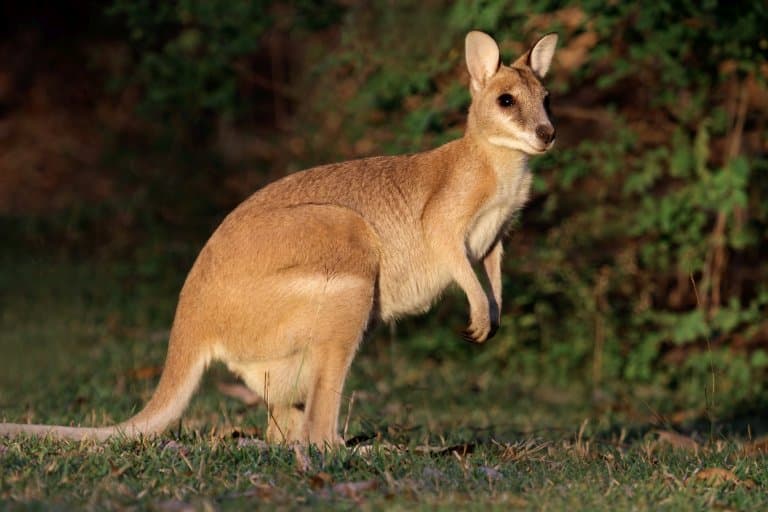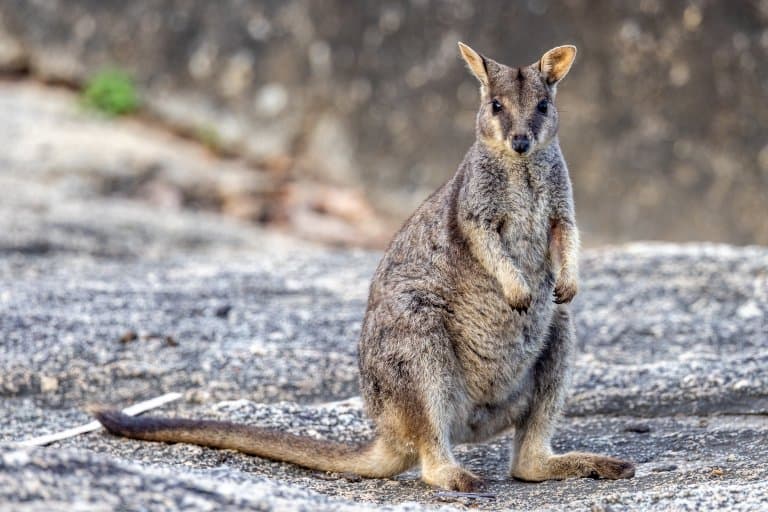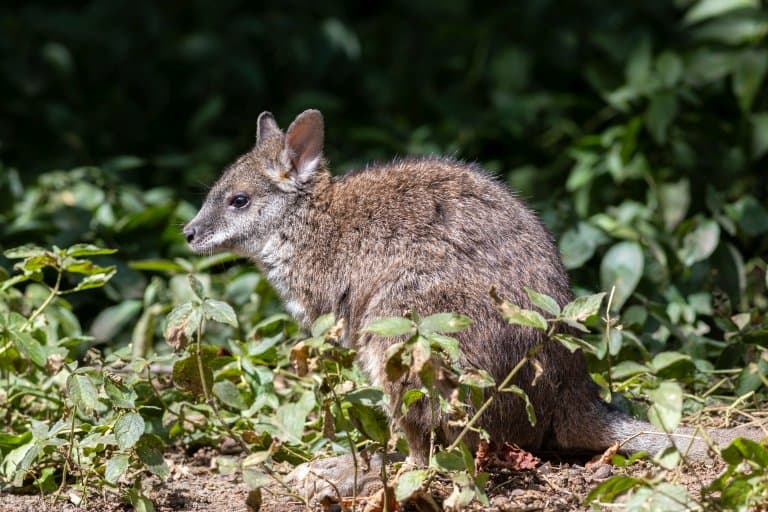Wallaby Profile
Very large and very small animals get all the attention. In marsupials, the enormous kangaroo and the tiny, adorable sugar glider are popular examples, yet the middle child is always the most neglected.
Wallabies are so overlooked as a group they don’t even have a taxonomic definition to call their own.

Wallaby Facts Overview
| Habitat: | Scrublands, grasslands, forests |
| Location: | Native to Australia and New Guinea, introduced elsewhere |
| Lifespan: | Around 15 years |
| Size: | Up to 81cm (32 inches) in large species |
| Weight: | Large species reach 18kg (40lb) |
| Color: | Grey/brown |
| Diet: | Grasses and herbs |
| Predators: | Humans, dingos |
| Top Speed: | Unconfirmed 32kmph (20mph) / At least 23kmph (14mph) |
| No. of Species: |
Around 45 |
| Conservation Status: |
Least Concern to Critically Endangered |
Wallabies are members of the Macropod family, along with kangaroos and their intermediate equivalents the wallaroos.
In fact, the difference between them all is based more on their looks than their biology.
There are 10 genus of wallabies and around 45 species in total. There’s 8 living species of the brush wallaby, 17 rock-wallabies, 2 hare-wallabies, 2 nail-tail wallabies, 7 scrub wallabies (known as pademelons), 7 forest wallabies, and a single species of swamp wallaby, and the quokka.
Wallabies are herbivores that eat a variety of grasses, vegetables, leaves, and other vegetation.
They’re exceptionally efficient in reproduction, locomotion and diet, and this is what gives them so much success both in their native habitats, and unfortunately as an invasive species.
In fact, they’re so powerful, wallaby defence systems have begun to rely on drones to fight back.
Interesting Wallaby Facts
1. Are they just small kangaroos?
Wallaby is a broad term, traditionally used to group all macropods (big feet) who weren’t accredited with the Kangaroo title or one of the other weird names like wallaroo or tree kangaroo.
The Eastern grey kangaroo, for example, was until recently listed as the same genus as all of the newly-classified Notamacropus wallaby species, until new assessments gave them their own genus.
So, there’s a loose taxonomic distinction between kangaroos and wallabies, but they are still poorly defined and generally represent the smaller terrestrial macropods.
One easy way to think of it is that Kangaroo is the word given to the four largest species of macropod, across two genera; wallabies are the remaining ten-or-so genera and about 45 species of land-based macropods that haven’t been given any other name.
If that’s still confusing, there are some buffer species of wallaroo, that represent everything too small to be a kangaroo and too big to be a wallaby. Easy, right?

2. Their tendons store energy
Being macropods, wallabies move by hopping. This appears to be a very inefficient way to get around, and when we make efforts to replicate it, we get tired pretty quickly. But it turns out, macropods like wallabies have found a low-cost solution to their locomotion needs.
Their tendons store energy on each bounce, acting along the same principles as a bouncy ball. One landing from one hop, that energy can be saved and released to power the next, significantly reducing the energy requirements on each bounce.
It’s been shown that this energy storage mechanism allows the animal to travel on less than a third of the expected oxygen requirements without it. 1
3. They are more agile than kangaroos
While the difference between wallabies and kangaroos may be mostly arbitrary in terms of taxonomy, size matters. The larger kangaroos have longer limbs and are faster animals in general, but the smaller wallabies get points back for agility.
If they’re approached by a predator they can’t outrun, wallabies will kick out in defence. Like kangaroos, their feet are equipped with powerful claws that can cause serious damage. 2
4. Embryonic diapause
This is such an interesting quirk of animal reproduction. Many marsupials are capable of this, and while it’s also found in some placental mammals, it’s more common in invertebrates and non-mammalian vertebrates.
Wallabies are one of the lucky few who can put a pause on their embryo’s development, a process known as embryonic diapause, allowing them to become pregnant and hold off on giving birth until favourable conditions arise.
They also have two uteri, allowing for one embryo to form while another is on hold in the second uterus. This rolling growth allows species like the swamp wallaby to remain pregnant almost their entire adult lives.
The use of a pouch makes their reproduction even more efficient. In less than a month, the embryo can vacate the uterus, climbing out of the vagina like a haunted doll and making its way up the mother’s fur to fully mature inside her pouch.

5. They can eat toxic plants
Another adaptation that makes these animals so successful is their ability to tolerate plant toxins to an exceptional degree.
They have detoxification systems in their bodies that help to process harmful terpenes found in plant defences, and they aid these systems by switching between plant sources to avoid overloading.
Their keen sense of smell allows them to pick out the right seedlings to eat, and this is one of the reasons they can be so amazing to local plant life, especially as an introduced species. 3
6. They can jump over one meter into the air
Rock wallabies are perhaps the most adept at hopping, at least on rugged terrain. They have exceptionally thick tendons in their feet that give them an advantage over other species in terms of the power they can generate.
They have more rapid acceleration than any kangaroo is capable of and have been seen jumping at least a meter high. Researchers studying their physiology predict the yellow-footed rock wallaby is capable of leaps of up to three meters high! 4

7. They’re invasive to New Zealand
Wallabies arrived in New Zealand in the 1870s, and after a lengthy establishment began a rapid explosion roughly a hundred years later.
The red-necked wallaby is one example of an introduced species that is wreaking havoc in South Canterbury, on the South Island. Their impressive breeding rate, agility, and generalist feeding habits make them a very successful coloniser, to the detriment of the plants, animals and local farmers in the region.
They compete with domestic sheep for forage, and even their droppings are repellent to the sheep. But a more serious threat comes from their destruction of native plant species.
The problem is so serious that there are millions of dollars going into wallaby control, involving drones and guns and night shooting just to get their numbers under control. 5
8. They have various threats
Alongside wallaby control in some regions, dingoes, feral dogs and red foxes are predators to wallabies.
Due to urbanization wallabies are increasing coming into contact with humans as well, in particular they are involved in more vehicle accidents, as they often feed near roadsides.
9. The Parma wallaby was recently rediscovered
The Parma wallaby is a smallest wallaby native to forests of southeastern Australia.
Before the end of the 19th century, it was believed that the Parma wallaby was extinct due to habitat loss and being easily killed by non-native foxes.
However, it was rediscovered in 1965 near Auckland, and another population was discovered in 1967 in New South Wales in Australia.
The species renames rarely seen, and is still classified as ‘near threatened’ by the IUCN.

10. They’ve been blamed for Australian crop circles
Australia produces over half of the world’s legally farmed opium, which is used to generate morphine and other medications.
According to a government official, Australian wallabies are consuming these opium poppies and hopping around “as high as a kite” in circles and circles – causing their own crop circles. 6
Wallaby Fact-File Summary
Scientific Classification
| Kingdom: | Animalia |
| Phylum: | Chordata |
| Class: | Mammalia |
| Order: | Diprotodontia |
| Family: | Macropodidae |
| Genus: | Notamacropus Wallabia Petrogale Lagostrophus Lagorchestes Onychogalea Dorcopsis Dorcopsulus Thylogale Setonix |
| Species: | Agile wallaby (Notamacropus agilis) Black-striped wallaby (Notamacropus dorsalis) Parma wallaby (Notamacropus parma) Red-necked wallaby or Bennett’s wallaby (Notamacropus rufogriseus) Tammar wallaby (Notamacropus eugenii) Western brush wallaby (Notamacropus irma) Whiptail wallaby (Notamacropus parryi) Swamp wallaby or black wallaby (Wallabia bicolor) Allied rock-wallaby (Petrogale assimilis) Black-flanked rock-wallaby (Petrogale lateralis) Brush-tailed rock-wallaby (Petrogale penicillata) Cape York rock-wallaby (Petrogale coenensis) Eastern short-eared rock-wallaby (Petrogale wilkinsi) Godman’s rock-wallaby (Petrogale godmani) Herbert’s rock-wallaby (Petrogale herberti) Mareeba rock-wallaby (Petrogale mareeba) Monjon (Petrogale burbidgei) Mount Claro rock-wallaby (Petrogale sharmani) Nabarlek (Petrogale concinna) Proserpine rock-wallaby (Petrogale persephone) Purple-necked rock-wallaby (Petrogale purpureicollis) Rothschild’s rock-wallaby (Petrogale rothschildi) Short-eared rock-wallaby (Petrogale brachyotis) Unadorned rock-wallaby (Petrogale inornata) Yellow-footed rock-wallaby (Petrogale xanthopus) Banded hare-wallaby (Lagostrophus fasciatus) Rufous hare-wallaby (Lagorchestes hirsutus) Spectacled hare-wallaby (Lagorchestes conspicillatus) Bridled nail-tail wallaby (Onychogalea fraenata) Northern nail-tail wallaby (Onychogalea unguifera) Black dorcopsis (Dorcopsis atrata) Brown dorcopsis (Dorcopsis muelleri) Gray dorcopsis (Dorcopsis luctuosa) White-striped dorcopsis (Dorcopsis hageni) Macleay’s dorcopsis (Dorcopsulus macleayi) Small dorcopsis (Dorcopsulus vanhuemi) Brown’s pademelon (Thylogale browni) Calaby’s pademelon (Thylogale calabyi) Dusky pademelon (Thylogale brunii) Mountain pademelon (Thylogale lanatus) Red-legged pademelon (Thylogale stigmatica) Red-necked pademelon (Thylogale thetis) Tasmanian pademelon (Thylogale billardierii) Quokka or short-tailed scrub wallaby (Setonix brachyurus) |
Fact Sources & References
- NICOLA J. DIMER (1987), “The role of tendon elasticity in hopping in a wallaby (Macropus rufogriseus)”, Department of Pure and Applied Zoology, University of Leeds, Leeds LS2 9JT.
- (2020), “Why is the female wallaby always pregnant?”, The University of Melbourne.
- Rebecca Stutz (2017), “Finding Food in the Forest: A Swamp Wallaby’s Guide”, Research Gate.
- C.P. McGowan (2008), “Differential design for hopping in two species of wallabies”, Science Direct.
- (2022), “Wallabies are destroying New Zealand’s forests and farms”, WewsHub.
- BBC News (2009, “Stoned wallabies make crop circles“, BBC.
